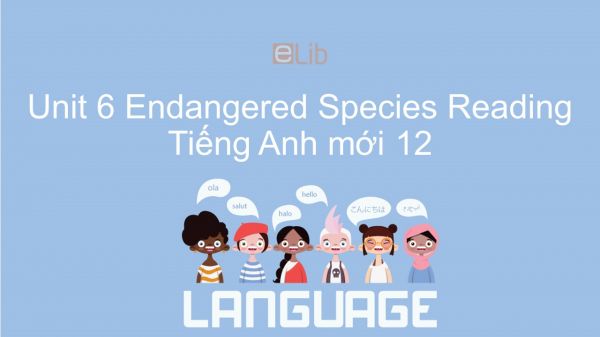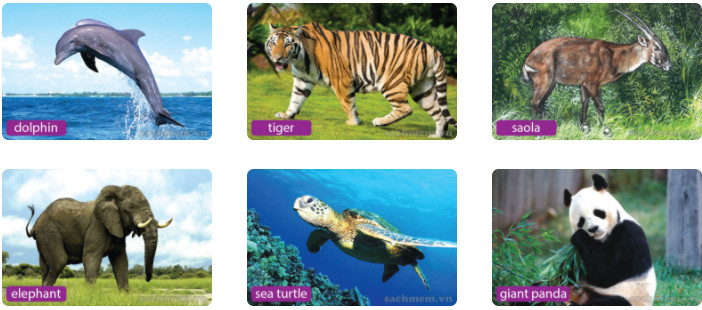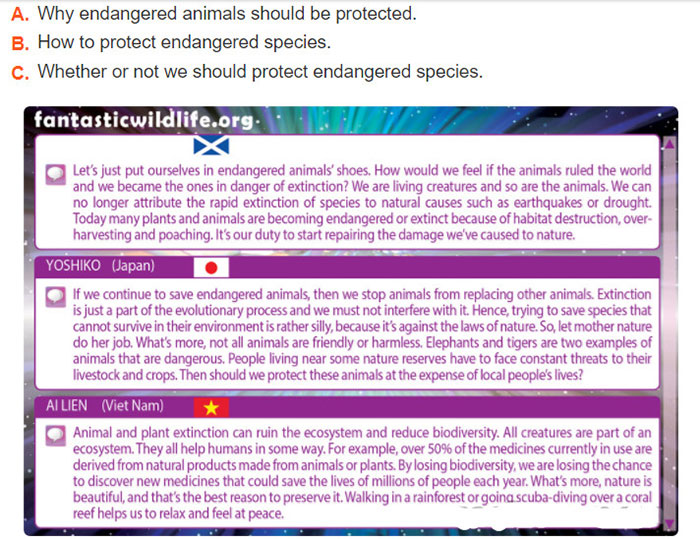Unit 6 lớp 12: Endangered Species - Reading
Bài học Unit 6 Lớp 12 mới phần Reading hướng dẫn các em tìm hiểu bài đọc ưu và nhược điểm của việc bảo vệ các loài vật có nguy cơ tuyệt chủng, thông qua một số dạng bài tập khác nhau. Mời các em cùng tham khảo!
Mục lục nội dung

Unit 6 lớp 12: Endangered Species - Reading
Saving endangered species: pros and cons (Bảo vệ các loài gặp nguy hiểm: ưu và nhược điểm)
1. Task 1 Unit 6 lớp 12 Reading
Discuss with a partner. (Thảo luận với một người bạn)

Guide to answer
a. Which of these animals are on the list of endangered species? (Những loài nào trong số các động vật này nằm trong danh sách các loài có nguy cơ bị tuyệt chủng?)
=> Tigers, saolas, elephants, sea turtles, and giant pandas are on the list of endangered species.
(Hổ, sao la, voi, rùa biển và gấu trúc nằm trong danh sách các loài có nguy cơ bị tuyệt chủng.)
b. Can you find them in Vietnam now? (Hiện giờ bạn có thể tìm thấy chúng ở VN hiện nay không?)
Yes, tigers, saolas, elephants and sea turtles are still found in Viet Nam, but each with a small population.
(Có, hổ, saola, voi và rùa biển vẫn còn được tìm thấy ở Việt Nam, nhưng mỗi loại đều số lượng nhỏ.)
2. Task 2 Unit 6 lớp 12 Reading
Below are three people's opinions posted on the fantasticwildlife.org website. Read the text and decide what they are talking about (Dưới đây là ba ý kiến của người dân được đăng trên trang web fantasticwildlife.org. Đọc văn bản và quyết định những gì họ đang nói về)

Guide to answer
C. Whether or not we should protect endangered species.
Tạm dịch:
A. Tại sao động vật có nguy cơ bị tuyệt chủng cần được bảo vệ
B. Làm thế nào để bảo vệ các loài có nguy cơ bị tuyệt chủng
C. Chúng ta có nên bảo vệ các loài có nguy cơ bị tuyệt chủng
SIMON (Scotland)
Chúng ta hãy tự đặt mình vào những con vật có nguy cơ tuyệt chủng. Chúng ta sẽ cảm thấy thế nào nếu những con vật cai trị thế giới và chúng ta đã trở thành những người có nguy cơ tuyệt chủng? Chúng ta là sinh vật sống và động vật cũng vậy. Chúng ta không còn có thể xác định sự tuyệt chủng nhanh chóng của các loài khi các nguyên nhân tự nhiên như động đất hoặc hạn hán. Ngày nay, nhiều loài thực vật và động vật đang bị đe doạ hoặc tuyệt chủng do sự phá huỷ môi trường sống, khai thác quá mức và săn trộm. Nhiệm vụ của chúng ta là khắc phục những thiệt hại mà chúng ta gây ra cho thiên nhiên.
YOSHIKO (Nhật Bản)
Nếu chúng ta tiếp tục cứu các động vật có nguy cơ tuyệt chủng, thì chúng ta sẽ không cho động vật thay thế các động vật khác. Sự tuyệt chủng chỉ là một phần của quá trình tiến hóa và chúng ta không được can thiệp vào nó. Do đó, cố gắng để cứu các loài không thể tồn tại trong môi trường của chúng là khá ngớ ngẩn, bởi vì nó là trái pháp luật của tự nhiên. Vì vậy, hãy để thiên nhiên thực hiện sứ mệnh. Hơn nữa, không phải tất cả các loài vật đều thân thiện hoặc vô hại. Voi và hổ là hai ví dụ về động vật nguy hiểm. Những người sống gần một số khu bảo tồn thiên nhiên phải đối mặt với những mối đe dọa liên tục đối với gia súc của họ và mùa màng. Vậy chúng ta nên bảo vệ những con vật này bằng cách chi trả cho cuộc sống của người dân địa phương?
ÁI LIÊN (Việt Nam)
Việc tuyệt chủng động vật và thực vật có thể hủy hoại hệ sinh thái và giảm đa dạng sinh học. Tất cả các sinh vật là một phần của hệ sinh thái. Tất cả chúng đều giúp con người theo một cách nào đó. Ví dụ, trên 50% thuốc hiện đang sử dụng có nguồn gốc từ các sản phẩm tự nhiên được làm từ động vật hoặc thực vật. Bằng cách mất đa dạng sinh học, chúng ta đang mất đi cơ hội để khám phá các loại thuốc mới có thể cứu được mạng sống của hàng triệu người mỗi năm. Hơn nữa, thiên nhiên là đẹp, và đó là lý do tốt nhất để bảo tồn nó. Đi bộ trong rừng nhiệt đới hoặc lướt ván trên một rạn san hô giúp chúng ta thư giãn và cảm thấy yên bình.
3. Task 3 Unit 6 lớp 12 Reading
Whose opinions are these? Write the correct name in the space before each statement.
(Những ý kiến này là của ai? Viết tên chính xác vào chỗ trống trước mỗi câu.)
Guide to answer
1. Ai Lien - There are two reasons why we should protect endangered species.
(Có hai lý do chúng ta nên bảo vệ các loài có nguy cơ bị tuyệt chủng.)
2. Yoshiko - There are two reasons why we shouldn't protect endangered species.
(Có hai lý do chúng ta không nên bảo vệ các loài có nguy cơ bị tuyệt chủng.)
3. Simon - Humans should be held responsible for endangering species or driving them to extinction.
(Con người phải chịu trách nhiệm đối với việc gây nguy hiểm cho các loài hoặc dẫn chúng đến sự tuyệt chủng.)
4. Yoshiko - Saving species in danger of extinction means going against the laws of nature.
(Bảo vệ những loài có nguy cơ tuyệt chủng có nghĩa là đi ngược lại quy luật tự nhiên.)
5. Simon - Humans and animals should get an equal chance of being protected from danger.
(Con người và động vật nên có cơ hội bình đẳng để được bảo vệ khỏi nguy hiểm.)
6. Ai Lien - Preserving animal and plant species helps to maintain biodiversity.
(Bảo tồn các loài động vật và thực vật giúp duy trì đa dạng sinh học.)
4. Task 4 Unit 6 lớp 12 Reading
Find the prepositions in the reading text to complete these phrases and expressions. Use a dictionary to find their meanings. (Tìm các giới từ trong bài đọc để hoàn thành các cụm từ và biểu thức. Sử dụng từ điển để tìm ý nghĩa của chúng.)
1. in (put oneself in someone's shoes = be in another person's situation)
(đặt mình vào vị trí của ai đó = vào vị trí của người khác)
2. to (attribute sth to sth else = believe that something is the result of a particular thing)
(quy cái này cho ai/ cái gì = tin tưởng rằng kết quả của thứ gì đó)
3. to (cause damage to something = harm something)
(gây thiệt hại cho cái gì = gây hại cho thứ gì đó)
4. with (interfere with something = prevent something from being done)
(gây trở ngại cho thứ gì đó = ngăn chặn thứ gì đó hoàn thành)
5. at (feel at peace = be free from anxiety or distress)
(cảm giác yên bình = không bị lo lắng hoặc đau khổ)
5. Task 5 Unit 6 lớp 12 Reading
Discuss with a partner. (Thảo luận với một người bạn.)
Which of the three people above do you agree with? Why? (Bạn đồng ý với ai trong số 3 người trên? Tại sao?)
Guide to answer
I agree with Simon (Scotland). Because, I think:
- Today many plants and animals are becoming endangered or extinct because of habitat destruction, over - harvesting and poaching. It's our duty to start repairing the damage we've caused to nature.
- We can no longer attribute the rapid extinction of species to natural cause such as earthquakes or drought.
Tạm dịch:
Tôi đồng ý với Simon (Scotland). Bởi vì tôi nghĩ rằng:
- Ngày nay nhiều loài thực vật và động vật đang bị đe doạ tuyệt chủng do sự phá huỷ môi trường sống, khai thác quá nhiều và săn trộm. Đó là nhiệm vụ của chúng ta để bắt đầu sửa những thiệt hại chúng ta đã gây ra cho thiên nhiên.
- Chúng ta không thể xác định sự tuyệt chủng nhanh chóng của các loài đối với một số nguyên nhân tự nhiên như động đất hoặc hạn hán.
6. Practice Task 1
Choose the letter A, B, C or D to complete the passage below
In 1973, when the tiger appeared to (1)______ facing extinction, the World Wide Fund for Nature and (2) _____Indian Government agreed to set up “Operation Tiger”- a campaign (3) ______ save this threatened creature. They started by creating nine special parks so that tigers could live in safety. The first was at Ranthambhore, a region (4) _____ was quickly turning into a desert as too much of the grass was being eaten by the local people’s cattle. At the time there (5) ______ just fourteen tigers left there. The government had to clear twelve small villages, which mean moving nearly 1,000 people and 10,000 cattle so the land could be handed back to nature.
Question 1: A. are B. be C. is D. was
Question 2: A. the B. X C. an D. a
Question 3: A. so B. so that C. because of D. to
Question 4: A. whom B. who C. which D. what
Question 5: A. are B. was C. is D. were
7. Practice Task 2
Choose the letter A, B, C or D to answer these following questions
Dinosaurs were reptiles that lived during a period of earth’s history called the Mesozoic Era, which is also known as the Age of Reptiles. The first dinosaurs appeared more than 200 million years ago. For many millions of years, they dominated the land with their huge size and strength. Then about 65 million years ago, they died out rather suddenly, never to re-emerge. The word “dinosauras” comes from two Greek words meaning “terrible lizard”. Dinosaurs were not lizards, but their appearance could be truly terrifying. The biggest ones weighed more than ten times as much as a mature elephant and nearly equalled the size of most modern-day whales. The famous kinds of dinosaurs, including the brontosaur and tyrannosaurus rex, reached 80 to 90 feet in length. Not all dinosaurs were giant, however, some were actually not larger than a chicken. Scientists still do not know what caused dinosaurs to disappear. One theory involves a change of the earth’s climate. It is believed that temperatures dropped significantly towards the end of the Cretaceous protection, it is possible that the climate became too chilly for dinosaurs. In contrast, other species having protection, such as the mammals and birds, were able to survive.
Question 1: What is the best title for this passage?
A. The History of Earth B. The Metabolism of Dinosaurs
C. Earth's Largest Reptiles D. The Domination of the
Question 2: It can be inferred from the passage that the Age of Reptiles lasted about_____.
A. 200 million years B. 135 million years
C. 80 million years D. 65 million years
Question 3: The author uses the phrase "never to re-emerge" to indicate that the dinosaurs_____.
A. went into hiding B. lost their way
C. became extinct D. never died out
Question 4: According to the passage, what is true about the size of dinosaurs?
A. It was rather uniform.
B. It guaranteed their survival.
C. It made them the largest creatures ever on earth.
D. It varied quite greatly
Question 5: Paragraph C most likely discusses_____.
A. other changes in the climate
B. another theory about the disappearance of dinosaurs
C. the ability of mammals to survive
D. the protection of other species
Để rèn luyện kĩ năng đọc hiểu, mời các em đến với phần trắc nghiệm Unit 6 Reading Tiếng Anh 12 mới ngay sau đây và cùng luyện tập.
9. Conclusion
Kết thúc bài học, các em cần luyện tập đọc hiểu và ghi nhớ các từ vựng sau:
- extinct /ɪkˈstɪŋkt/(a): tuyệt chủng
- extinction /ɪkˈstɪŋkʃn/(n): sự tuyệt chủng
- habitat /ˈhæbɪtæt/(n): môi trường sống
- poach/pəʊtʃ/ (v): săn trộm
- rhino/ rhinoceros /raɪˈnɒsərəs/(n): hà mã
- sea turtle /siː ˈtɜːtl/(n): con rùa biển
Tham khảo thêm
- doc Unit 6 lớp 12: Endangered Species - Getting Started
- doc Unit 6 lớp 12: Endangered Species - Language
- doc Unit 6 lớp 12: Endangered Species - Speaking
- doc Unit 6 lớp 12: Endangered Species - Listening
- doc Unit 6 lớp 12: Endangered Species - Writing
- doc Unit 6 lớp 12: Endangered Species - Communication and Culture
- doc Unit 6 lớp 12: Endangered Species - Looking Back
- doc Unit 6 lớp 12: Endangered Species - Project




